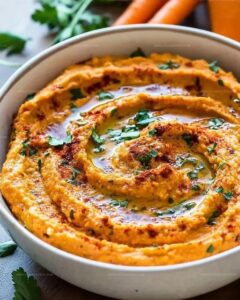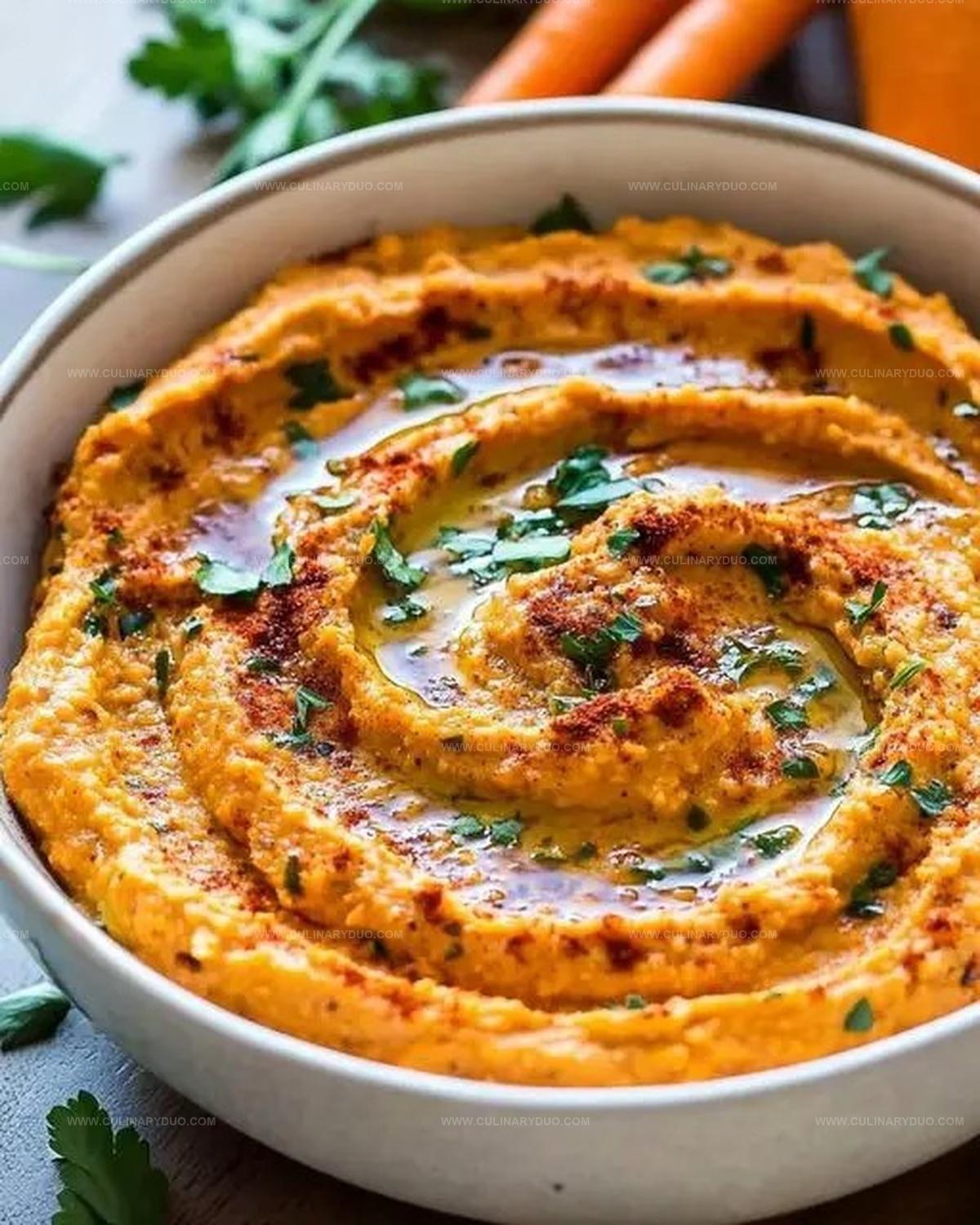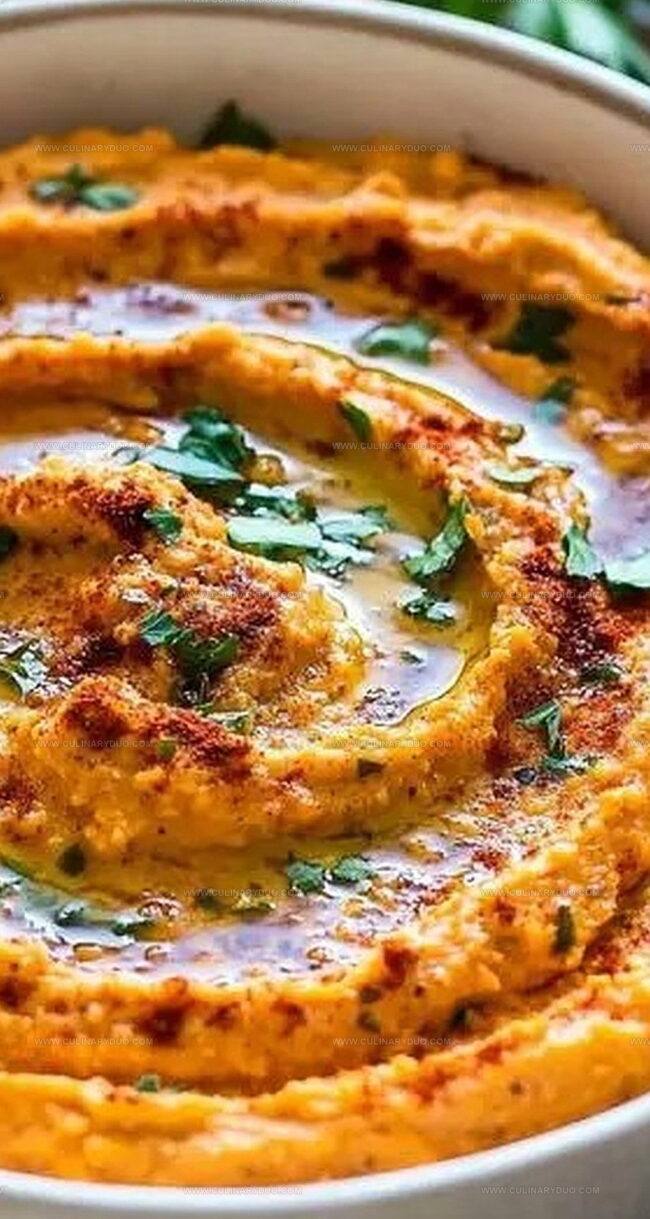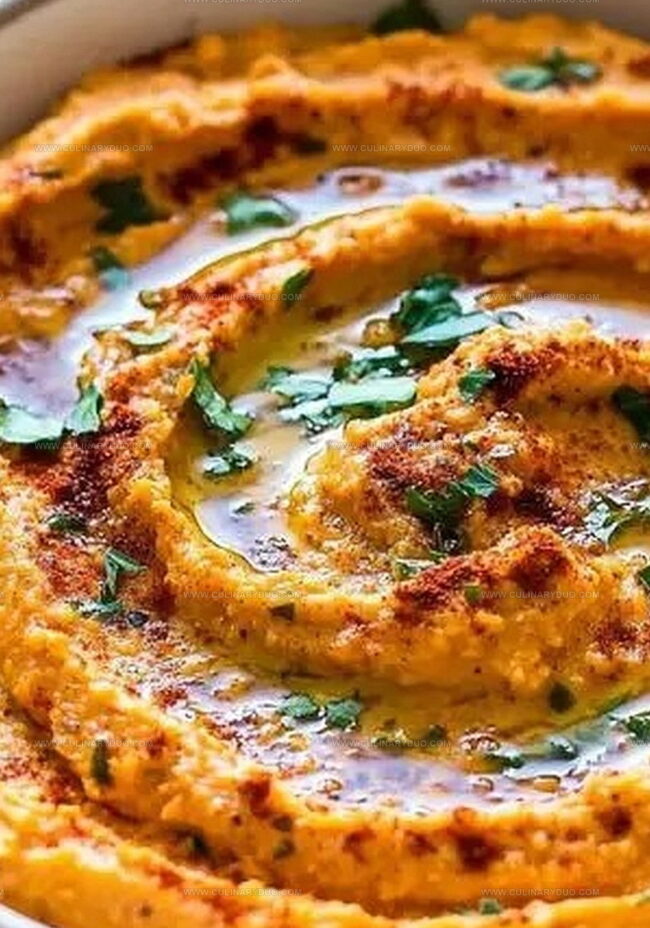Creamy Roasted Carrot Hummus Recipe: A Zesty Flavor Twist
Every cook loves discovering unexpected twists on classic hummus, and this roasted carrot hummus brings surprising warmth to your appetizer lineup.
Caramelized carrots infuse deep, sweet complexity into traditional chickpea spread.
Mediterranean kitchens inspire this vibrant orange dip that feels simultaneously rustic and elegant.
Robust spices dance alongside mellow roasted vegetable notes, creating an irresistible combination.
Sharp garlic undertones complement the carrots’ natural sweetness, making each bite memorable.
Smooth textures and rich flavors promise to impress anyone who samples this unique preparation.
Why Roasted Carrot Hummus Is Delicious
Ingredients For Roasted Carrot Hummus
Main Ingredients:Seasoning Ingredients:Oil and Creamy Ingredients:How To Make Roasted Carrot Hummus
Step 1: Prepare Carrots and Seasonings
Wash and peel carrots, then slice them into uniform pieces.
Create a bold seasoning blend with the following ingredients:Toss the carrots thoroughly with the seasoning mixture until each piece is evenly coated.
Step 2: Roast Carrots and Garlic
Spread seasoned carrots in a single layer on a large baking sheet.
Wrap whole garlic cloves in aluminum foil with a small drizzle of olive oil.
Place garlic packet on the same baking sheet.
Roast everything in a preheated oven at 400°F for 25-30 minutes until carrots become tender and slightly caramelized.
Step 3: Blend Hummus Base
Remove roasted carrots and garlic from the oven.
Squeeze roasted garlic cloves out of their skins.
Add the following ingredients to a food processor:Blend ingredients until completely smooth and creamy.
Step 4: Garnish and Serve
Transfer hummus to a serving bowl.
Enhance with additional olive oil drizzle.
Sprinkle Za’atar seasoning and chopped fresh parsley on top.
Serve alongside pita chips, fresh vegetable sticks, or warm bread for dipping.
Tips For Roasted Carrot Hummus
Flavor Twists For Roasted Carrot Hummus
Suggested Pairings For Roasted Carrot Hummus
Storage Guidelines For Roasted Carrot Hummus
FAQs
Roasting concentrates the natural sugars in carrots, creating a deeper, sweeter flavor profile and adding caramelized notes that enhance the overall taste of the hummus.
Yes, ground spices work perfectly. Just ensure they are fresh and fragrant to maintain the robust flavor of the roasted carrot hummus.
Tahini is crucial as it provides a nutty, creamy texture and authentic Middle Eastern flavor that balances the sweetness of roasted carrots and complements the chickpeas.
While not mandatory, Za’atar adds a traditional Middle Eastern herb and spice blend that elevates the hummus with complex, aromatic notes and visual appeal.
Print
Roasted Carrot Hummus Recipe
- Total Time: 45 minutes
- Yield: 6 1x
Description
Mediterranean magic meets humble carrots in this roasted carrot hummus, blending smoky sweetness with creamy tahini. Silky smooth and packed with earthy flavors, you’ll discover a dip that elevates any gathering with its rustic charm and nourishing appeal.
Ingredients
Roasted Vegetables:
- 1 pound (454 grams) carrots
- 4 cloves garlic
Spices and Seasonings:
- 2 teaspoons smoked paprika
- 1 teaspoon cumin
- 1 1/2 teaspoons salt
- 1/2 teaspoon black pepper
- 1/4 teaspoon cayenne pepper
- Za’atar seasoning (to taste)
- Fresh parsley (to taste)
Main Ingredients and Liquids:
- 14 ounces (397 grams) can chickpeas
- 6 tablespoons (90 milliliters) olive oil (divided)
- 2 tablespoons (30 milliliters) tahini
- 2 tablespoons (30 milliliters) lemon juice
Instructions
- Prepare carrots by peeling and slicing them into uniform pieces, then transfer to a spacious mixing bowl.
- Create a robust seasoning blend by whisking olive oil with salt, pepper, cumin, smoked paprika, and cayenne pepper. Generously coat carrots with this aromatic mixture, ensuring even distribution across a rimmed baking sheet.
- Encase whole garlic cloves in aluminum foil, drizzling with a touch of olive oil, and place alongside seasoned carrots on the baking tray.
- Roast vegetables in a preheated oven at 400°F for approximately 25-30 minutes, until carrots become tender and slightly caramelized.
- Transfer roasted carrots and caramelized garlic (extracted from its skin) into a food processor. Add undrained chickpeas, fresh lemon juice, tahini, and additional olive oil to create a smooth, velvety mixture.
- Pulse and blend the ingredients until achieving a creamy, uniform consistency with no visible chunks.
- Plate the hummus in a serving bowl, enhancing its presentation by drizzling extra olive oil and sprinkling Za’atar seasoning and freshly chopped parsley on top.
- Serve immediately alongside warm pita chips, crisp vegetable crudités, or rustic bread for an inviting dipping experience.
Notes
- Maximize flavor by roasting carrots until they develop caramelized edges, creating deeper, sweeter taste notes.
- Adjust spice levels by controlling cayenne pepper amount, making the hummus mild or fiery based on personal preference.
- Enhance texture by processing longer for ultra-smooth consistency or briefly for rustic, chunky dip experience.
- Transform recipe into vegan-friendly option by ensuring all ingredients meet plant-based dietary requirements.
- Prep Time: 15 minutes
- Cook Time: 30 minutes
- Category: Appetizer, Snacks
- Method: Roasting
- Cuisine: Middle Eastern
Nutrition
- Serving Size: 6
- Calories: 171 kcal
- Sugar: 3 g
- Sodium: 630 mg
- Fat: 11 g
- Saturated Fat: 1.5 g
- Unsaturated Fat: 8.5 g
- Trans Fat: 0 g
- Carbohydrates: 15 g
- Fiber: 4 g
- Protein: 4 g
- Cholesterol: 0 mg




Natalie Brooks
Co-Founder & Content Strategist
Expertise
Education
eCornell
Natalie brings the vibrant, plant-powered side to Culinary Duo. After earning her Plant-Based Nutrition Certificate from eCornell, she combined her love for fresh ingredients with a passion for storytelling, aiming to make healthy cooking simple and satisfying.
Her kitchen motto: good food doesn’t need a fancy label, it just needs fresh ideas and a little creativity. Outside of writing and recipe testing, Natalie’s happiest in her garden, exploring farmers’ markets, or mixing global flavors into new kitchen experiments.